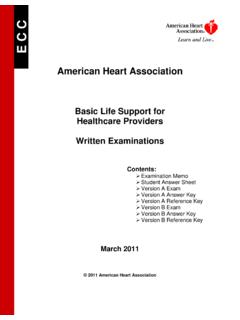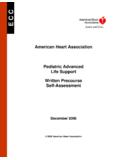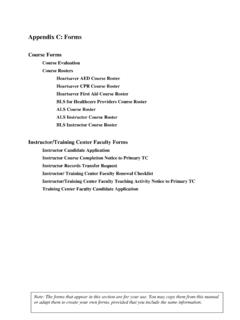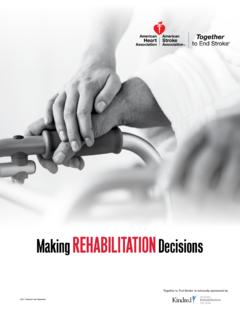Transcription of Advanced Cardiac Life Support (ACLS) Review …
1 Advanced Cardiac life Support ( acls ) Review . Reviewed February, 2018, Expires February, 2020. Provider Information and Specifics available on our Website Unauthorized Distribution Prohibited 2018 , , , LLC. Developed by Dana Bartlett, RN, MSN. Advanced Cardiac life Support ( acls ) is a two day course that teaches students to recognize and treat Cardiac arrest, arrhythmias, acute coronary syndromes, stroke, Cardiac arrest in the pregnant woman, and Cardiac arrest in situations involving drug overdose, drowning, anaphylaxis, hypothermia, and electrocution. The acls course involves lectures, self-study, and simulations of the medical emergencies. Drugs, Advanced airways, defibrillation, cardioversion, Cardiac pacing, are all covered. OBJECTIVES. When the student has finished this module, he/she will be able to: 1. Identify VF, pulseless VT, and PEA.
2 2. Know the indications for using amiodarone. 3. Identify the basic principles of stroke care. 4. Recognize the components of a basic stroke assessment. 5. Identify the appropriate treatment for STEMI. 6. Identify the indications for using adenosine. 7. Correctly identify aspects of the acls algorithm for tachycardia. 8. Recognize the indications/safety measures of using defibrillation, cardioversion. 9. Identify a basic method of arrhythmia recognition. 10. Identify the indications for using vasopressin 11. Recognize three conditions for which epinephrine is a first-line treatment. 12. Identify the ECG characteristics of third-degree heart block. 13. Identify the antidote for digoxin toxicity. 14. Identify the primary use for atropine, and the correct dose. 15. Recognize treatments for Cardiac arrest caused by drowning, hypothermia 16. Recognize treatments for Cardiac arrest caused by electrocution, anaphylaxis.
3 17. Recognize how to treat Cardiac arrest in pregnant women and after an overdose. 18. Identify four therapies that should not be routinely used to treat Cardiac arrest. 19. Identify treatments for VF, pulseless VT, and unstable bradycardia, 20. Identify three aspects of pacemaker function that must be assessed. ABBREVIATIONS. ACS: Acute coronary syndromes AED: Automatic external defibrillator AF: Atrial fibrillation BLS: Basic life Support . NSTEMI: Non-ST-segment myocardial infarction PEA: Pulseless electrical activity PCI: Percutaneous coronary intervention. PSVT: Paroxysmal supraventricular tachycardia STEMI: ST-segment elevation myocardial infarction SVT: Supraventricular tachycardia TDP: Torsades de pointes VF: Ventricular fibrillation VT: Ventricular tachycardia STARTING OUT. The first step in acls is ABCD. Assess airway, breathing, and circulation, and determine whether defibrillation is needed.
4 If the victim is unconscious, apneic and pulseless, activate the EMS system/call for help and prepare to defibrillate. Remember: The American Heart Association has revised BLS. protocol. It is now recommended that Cardiac compressions be done first. It is felt that even in someone who has suffered a Cardiac arrest, there is enough oxygen saturation in the blood so that circulation of the oxygenated blood is a more important concern immediately after Cardiac arrest. Learning Break: If the victim has/suspected to have a cervical spine injury and is lying face down, the current acls guidelines consider it acceptable to roll the victim to the supine position. Restrict motion of the spine and keep the head, neck, and spine in alignment. Learning Break: Regardless of the where you are or the situation, it is vital that you call for help or activate the EMS system.
5 BLS techniques can provide temporizing care, but the medical emergencies covered in acls require sophisticated and complex care. BLS may prevent someone from dying immediately, but if the patient has suffered an MI or VF, etc., BLS will not keep them alive. AIRWAY MANAGEMENT. Airway control in medical emergencies is critical. If the victim is apneic, has no gag reflex, or is not ventilating adequately, an Advanced airway may be needed to a) protect airway patency, and b) deliver oxygen efficiently. There are complicated methods that can be usedd to assess whether or nor someone needs an Advanced airway. However, in many of the medical emergencies discussed in acls , the patient is apneic and pulseless and the need for an Advanced airway is obvious. Common Advanced airways are the endotracheal tube (ET), esophageal- tracheal double lumen airway, and the laryngeal mask airway (LMA).
6 When inserting an Advanced airway, each attempt should last no longer than 30. seconds; oxygenate with 100% O2 between attempts. Confirm correct airway position (an end-tidal CO2 works best), and then secure it. Endotracheal tube: The ETT delivers oxygen very efficiently and protects well against aspiration. Esophageal-tracheal double lumen airway: This has a tracheal lumen, an esophageal lumen and a cuff that seals the airway. It can be inserted by personnel not authorized for endotracheal intubation. The patient can be ventilated and protected against aspiration even if the tracheal lumen is inserted into the esophagus. Laryngeal mask airway: The LMA has an airway attached to a face mask, but does not have an inflatable cuff to protect against aspiration. It is quick to use and can be inserted by personnel that are not authorized for endotracheal intubation.
7 Learning Break: The LMA and the esophageal-tracheal double lumen airway are not intended for long-term use. If the victim does not need an Advanced airway, but needs supplemental oxygen, a nasal cannula, Venturi mask, simple face mask, or nonrebreather mask are possibilities. The amount and precision of oxygen delivery differs with each device. PHARMACOLOGY. The following drugs are the one most commonly used in acls . Some could fit into more than one category. Antidotes Naloxone: Naloxone is a competitive antagonist at opioid receptors used to reverse respiratory depression caused by opioid overdose. Dose: mg, IV; repeat PRN every few minutes, up to 10 mg. It can be given IM, SC, and via an ETT. Adverse effects: Agitation and tachycardia, caused by return to conscious and/or precipitation of withdrawal. Contraindications: Use cautiously if the patient has cardiovascular disease or cardiovascular instability.
8 Flumazenil: Flumazenil is a competitive antagonist at benzodiazepine receptor sites. It is used to reverse sedation and respiratory depression caused by benzodiazepines. Dose: mg IV over 15 seconds. If no response, give mg IV over 30 seconds; no response, give mg over 30 seconds; no response, mg at 1 minute intervals to a total of 3 mg. Adverse effects: Agitation, hypertension, seizures. Contraindications: Seizure disorder, overdose with a tricyclic antidepressant, benzodiazepine dependency, head injuries. Glucagon: Glucagon acts a positive inotrope, dromotrope, and chronotrope by increasing intracellular concentrations of cAMP. Glucagon is used to reverse the effects of beta blocker and calcium channel blockers. Dose: 3-10 mg IV over 1 minute: continuous infusion of 1-5. mg/H as needed. Adverse effects: Vomiting, hypotension. Contraindications: Sensitivity to glucagon, pheochromocytoma.
9 Glucagon is not compatible with normal saline solution. Digoxin-specific antibody fragments: Aka Fab fragments. These bind to digoxin and decrease serum digoxin level. They are used to treat digoxin toxicity. Dose: Based on the serum digoxin level or the amount of digoxin ingested. Give the dose IV over 30 minutes using a 22 micron filter. Adverse effects: Precipitation of heart failure, hypokalemia, rapid ventricular rate in patients with atrial fibrillation. No contraindications. Glucose and insulin: This combination has been used to treat beta- blocker and calcium channel blocker overdose. Empirical dosing. Calcium: Used to treat calcium channel blocker and beta blocker overdose. Dosing is empirical: start with 1 gm calcium chloride, IV bolus, repeat PRN. Cyanide antidote: Sodium thiosulfate. Dose: g IV, rapid IV or over 10-30 minutes as needed.
10 Nitrites induce methemoglobinemia and prevent cyanide binding to hemoglobin, but must be used cautiously. Cyanocobalamine also binds cyanide and is safer. Sodium bicarbonate: Used to treat overdose with tricyclic antidepressants. Dosing is empirical: use boluses and continuous IV. infusion to maintain blood pH between Vasopressors Dopamine: Dopamine stimulates alpha and beta-1 receptors. It is used to treat hypotension and unstable bradycardia. Low doses have a positive inotropic and chronotropic action; high doses cause peripheral vasoconstriction. Dose: IV infusion, titrate PRN, doses > 50 mcg/kg/min cause arrhythmias and vasoconstriction. Correct hypovolemia before using dopamine, and do not mix dopamine with alkaline solutions/medications. Adverse effects: Hypertension, arrhythmias. Contraindications: Tachyarrhythmias, ventricular arrhythmias, hypovolemia.














